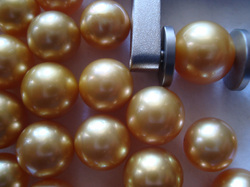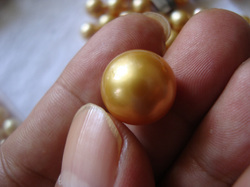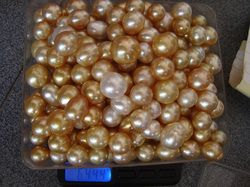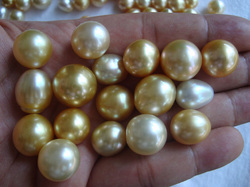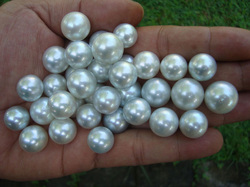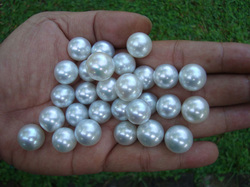Cultured Loose Golden South Sea Pearls
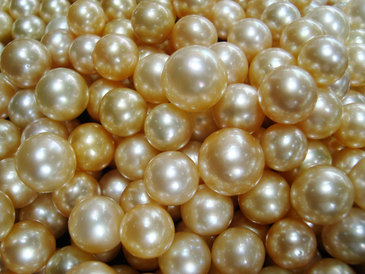
This cultured golden loose south sea pearls in Lombok exquisite piece is part of our Ultimate collection, the finest and most-extensive line of top quality Golden South Sea cultured loose pearl standard International
Loose golden pearls showcases as well prepared 10 mm to 16 mm pearls and is an overall A+ quality - combining A+ and B+ luster with a clear and sharp reflection, A+ body surface grade and AA+ rated perfect roundness and semi round. These rare and combined factors make this a very valuable necklace indeed. In addition, Lombok Golden South Sea cultured pearls do command a higher value. Our exquisite South Sea collection showcases amazing color saturation with a deep golden shine. Our South Sea cultured pearls come in shades of lustrous silver, gold, white, yellow, pink and champagne. Today, all pearls are cultured, as opposed to natural -- but their color is naturally produced by the oyster.Cultivation of blister pearls on Pinctada maxima shells started several years ago near the coast of Lombok island, in particular Lombok Golden Pearls, around the very small island (isle) Gili Air. Three shells from this area with a total of nine mabe 'pearls' were examined and found to have hemispherical bead nuclei composed of artificial resin instead of mother-of-pearl or soapstone. These cultured blister pearls are sold on Lombok and Bali islands Indonesia as natural pearls.Pinctada Maxima is observed to have various external colors: light yellowish-brown, green, dark brown or purple. The nacre (i.e. the hard pearly inside layer of the oyster shell) has a clear and rich luster. Part of the nacre close to "its mouth" can have a golden or silver band of varying width. This gives Pinctada Maxima its common name of gold-lip or silver-lip oyster.
We prepare selecting your choice of Golden Pearls Natural Colour offer size 6mm till 18mm shape round, baroque, drop, button and circle unique.
Loose golden pearls showcases as well prepared 10 mm to 16 mm pearls and is an overall A+ quality - combining A+ and B+ luster with a clear and sharp reflection, A+ body surface grade and AA+ rated perfect roundness and semi round. These rare and combined factors make this a very valuable necklace indeed. In addition, Lombok Golden South Sea cultured pearls do command a higher value. Our exquisite South Sea collection showcases amazing color saturation with a deep golden shine. Our South Sea cultured pearls come in shades of lustrous silver, gold, white, yellow, pink and champagne. Today, all pearls are cultured, as opposed to natural -- but their color is naturally produced by the oyster.Cultivation of blister pearls on Pinctada maxima shells started several years ago near the coast of Lombok island, in particular Lombok Golden Pearls, around the very small island (isle) Gili Air. Three shells from this area with a total of nine mabe 'pearls' were examined and found to have hemispherical bead nuclei composed of artificial resin instead of mother-of-pearl or soapstone. These cultured blister pearls are sold on Lombok and Bali islands Indonesia as natural pearls.Pinctada Maxima is observed to have various external colors: light yellowish-brown, green, dark brown or purple. The nacre (i.e. the hard pearly inside layer of the oyster shell) has a clear and rich luster. Part of the nacre close to "its mouth" can have a golden or silver band of varying width. This gives Pinctada Maxima its common name of gold-lip or silver-lip oyster.
We prepare selecting your choice of Golden Pearls Natural Colour offer size 6mm till 18mm shape round, baroque, drop, button and circle unique.
Keshi Pearls
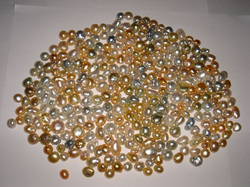
What's Keshi pearls?
Keshi pearls are formed when the oyster rejects and spits out the implanted nucleus before the culturing process is complete, or the implanted mantle tissue fractures and forms separate pearl sacs without nuclei. These pearl sacs eventually produce pearls without a nucleus.
Keshi may form in either saltwater or freshwater pearls. They are generally small in size and, because there was no nucleus to guide the ultimate shaping of the pearl, their shapes vary widely. Keshi come in a wide variety of colors, and tend to have high luster and even rare orient. This is due to their solid-nacre composition.
Because the implanted nucleus of the pearl has been expelled by the oyster, the resulting keshi pearl is 100% nacre. This gives it an especially lustrous and shimmering surface quality. Most keshi, in fact, have a greater luster than even the best-quality cultured pearls. The fact that keshi pearl are solid nacre does not, however, give them the classification of natural pearls. This is because keshi are a bi-product of the culturing process, not a natural occurrence.
Keshi pearls, especially Golden and South Sea Pearls, were once quite the bargain yet beautiful and unique pieces. Today Keshi pearls are much more rare. This is because Golden and South Sea pearl farms are now x-raying oysters to determine whether or not the nucleus has been expelled. When a nucleus-free oyster is found they are then re nucleated before a keshi has time to form. This practice has made keshi pearls much more of a rare find than they once used to be.
Keshi pearls from both white and black South Sea pearl oysters can reach any size from 4 to 10 millimeters above.
The word keshi means "poppy seed" in Japanese, and these pearls are often also referred to as "poppy seed pearls.
Keshy pearls they are shaped very beautiful and has a very good light quality, nacre and almost no blemishing, has the best quality with international standards, of all sizes are available starting at approximately 9mm to 20mm or more, either loose pearls wholesale and auction at the pound (in quantity) and collect the best option.
Keshi pearls are formed when the oyster rejects and spits out the implanted nucleus before the culturing process is complete, or the implanted mantle tissue fractures and forms separate pearl sacs without nuclei. These pearl sacs eventually produce pearls without a nucleus.
Keshi may form in either saltwater or freshwater pearls. They are generally small in size and, because there was no nucleus to guide the ultimate shaping of the pearl, their shapes vary widely. Keshi come in a wide variety of colors, and tend to have high luster and even rare orient. This is due to their solid-nacre composition.
Because the implanted nucleus of the pearl has been expelled by the oyster, the resulting keshi pearl is 100% nacre. This gives it an especially lustrous and shimmering surface quality. Most keshi, in fact, have a greater luster than even the best-quality cultured pearls. The fact that keshi pearl are solid nacre does not, however, give them the classification of natural pearls. This is because keshi are a bi-product of the culturing process, not a natural occurrence.
Keshi pearls, especially Golden and South Sea Pearls, were once quite the bargain yet beautiful and unique pieces. Today Keshi pearls are much more rare. This is because Golden and South Sea pearl farms are now x-raying oysters to determine whether or not the nucleus has been expelled. When a nucleus-free oyster is found they are then re nucleated before a keshi has time to form. This practice has made keshi pearls much more of a rare find than they once used to be.
Keshi pearls from both white and black South Sea pearl oysters can reach any size from 4 to 10 millimeters above.
The word keshi means "poppy seed" in Japanese, and these pearls are often also referred to as "poppy seed pearls.
Keshy pearls they are shaped very beautiful and has a very good light quality, nacre and almost no blemishing, has the best quality with international standards, of all sizes are available starting at approximately 9mm to 20mm or more, either loose pearls wholesale and auction at the pound (in quantity) and collect the best option.
Cultured Silver South Sea Pearls

This cultured silver loose south sea pearls in Lombok exquisite piece is part of our Ultimate collection, the finest and most-extensive line of top quality Silver South Sea cultured loose pearl standard International
Loose Silver pearls showcases as well prepared 10 mm to 16 mm pearls and is an overall A+ quality - combining A+ and B+ luster with a clear and sharp reflection, A+ body surface grade and AA+ rated perfect roundness and semi round. In addition, Lombok Silver South Sea cultured pearls do command a higher value. Our exquisite South Sea collection showcases amazing color saturation with a deep Silver shine. Our South Sea cultured pearls come in shades of lustrous silver, gold, white, yellow, pink and champagne. Today, all pearls are cultured, as opposed to natural -- but their color is naturally produced by the oyster.Cultivation of blister pearls on Pinctada maxima shells started several years ago near the coast of Lombok island, in particular Lombok Golden Pearls, around the very small island (isle) Gili Air. Three shells from this area with a total of nine mabe 'pearls' were examined and found to have hemispherical bead nuclei composed of artificial resin instead of mother-of-pearl or soapstone. These cultured blister pearls are sold on Lombok and Bali islands Indonesia as natural pearls.
Loose Silver pearls showcases as well prepared 10 mm to 16 mm pearls and is an overall A+ quality - combining A+ and B+ luster with a clear and sharp reflection, A+ body surface grade and AA+ rated perfect roundness and semi round. In addition, Lombok Silver South Sea cultured pearls do command a higher value. Our exquisite South Sea collection showcases amazing color saturation with a deep Silver shine. Our South Sea cultured pearls come in shades of lustrous silver, gold, white, yellow, pink and champagne. Today, all pearls are cultured, as opposed to natural -- but their color is naturally produced by the oyster.Cultivation of blister pearls on Pinctada maxima shells started several years ago near the coast of Lombok island, in particular Lombok Golden Pearls, around the very small island (isle) Gili Air. Three shells from this area with a total of nine mabe 'pearls' were examined and found to have hemispherical bead nuclei composed of artificial resin instead of mother-of-pearl or soapstone. These cultured blister pearls are sold on Lombok and Bali islands Indonesia as natural pearls.
Black Tahitian South Sea Pearls
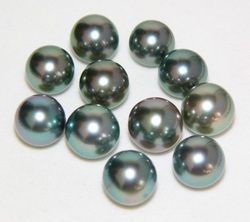
Tahitian Pearls – Among The Most Beautiful In The World
Tahitian pearls are produced in the black-lipped oyster ‘Pinctada margaritifera’, in and around Tahiti and the French Polynesian islands. This oyster itself is quite large - sometimes over 12 inches across and weighing as much as 10 pounds - which often results in much larger-than-average pearls. The pearls are unique because of their natural dark colors. Most "black" Tahitian pearls are not actually black, but are instead silver, charcoal, or a multitude of colors with the dominant color being green. Truly black pearls are among the most beautiful pearls in the world, and are extremely rare.
Almost Hunted To Extinction
Not only are the pearls beautiful, but the black-lipped oyster's mother-of-pearl inner shell is also extremely attractive. By the early part of the 20th century, before conservation and repopulation efforts began, the Tahitian pearl oyster had almost been hunted to extinction for its shell alone.
Although Tahitian pearls are thought by many to be solely a product of Tahiti, this is in fact not true. Tahiti is the commercial center and trading hub for the bulk of the industry, however Tahiti does not have any pearl farms actually located on the island. The farms are instead scattered throughout French Polynesia, as far east as the Gambier Islands, and beyond French Polynesia to the west into the Micronesian Islands. Australia, the Seychelles and Vietnam have all produced black pearls as well, but those cannot be referred to as Tahitian pearls.
Tahitian Pearl Farming Begins
Tahitian pearl farming has much later commercial origins than its other cultured pearl cousins. In the early 1960's a man by the name of Jean-Marie Domard began experimenting with the ‘Pinctada margaritifera’ using Japanese culturing techniques. In 1962, Mr. Domard successfully nucleated 5,000 oysters, and after 3 years harvested more than 1000 high-quality Tahitian pearls.
"We Prepare offer size 6mm till 16mm shape round, baroque, drop, button and circle unique with green colors (peacock) and other more variety multiple colors"
Tahitian pearls are produced in the black-lipped oyster ‘Pinctada margaritifera’, in and around Tahiti and the French Polynesian islands. This oyster itself is quite large - sometimes over 12 inches across and weighing as much as 10 pounds - which often results in much larger-than-average pearls. The pearls are unique because of their natural dark colors. Most "black" Tahitian pearls are not actually black, but are instead silver, charcoal, or a multitude of colors with the dominant color being green. Truly black pearls are among the most beautiful pearls in the world, and are extremely rare.
Almost Hunted To Extinction
Not only are the pearls beautiful, but the black-lipped oyster's mother-of-pearl inner shell is also extremely attractive. By the early part of the 20th century, before conservation and repopulation efforts began, the Tahitian pearl oyster had almost been hunted to extinction for its shell alone.
Although Tahitian pearls are thought by many to be solely a product of Tahiti, this is in fact not true. Tahiti is the commercial center and trading hub for the bulk of the industry, however Tahiti does not have any pearl farms actually located on the island. The farms are instead scattered throughout French Polynesia, as far east as the Gambier Islands, and beyond French Polynesia to the west into the Micronesian Islands. Australia, the Seychelles and Vietnam have all produced black pearls as well, but those cannot be referred to as Tahitian pearls.
Tahitian Pearl Farming Begins
Tahitian pearl farming has much later commercial origins than its other cultured pearl cousins. In the early 1960's a man by the name of Jean-Marie Domard began experimenting with the ‘Pinctada margaritifera’ using Japanese culturing techniques. In 1962, Mr. Domard successfully nucleated 5,000 oysters, and after 3 years harvested more than 1000 high-quality Tahitian pearls.
"We Prepare offer size 6mm till 16mm shape round, baroque, drop, button and circle unique with green colors (peacock) and other more variety multiple colors"
